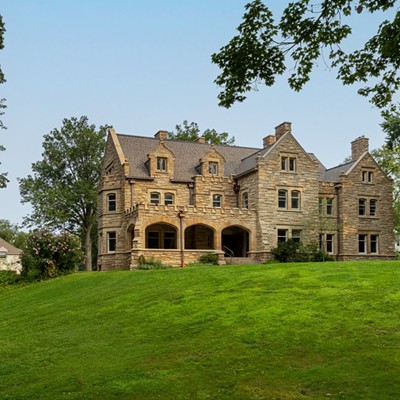Barcelona & Modernity -- Instability breeds creativity. Cling to that underlying principle throughout this unique, immense, and also indigestible exhibition examining Barcelona's 1868-1939 transformation -- through war, artistic breakthrough, and social upheaval -- from provincial city into cultural capital. Catalonia (the Spanish region that includes Barcelona) built a formidable legacy at that time, with painters Miró, Dalí, a young Picasso, and many lesser-known talents. Famous works by each are abundant here, including Picasso's Blue Period icon "La Vie" and, later, Dalí's Surrealist calling card "Soft Construction With Boiled Beans." But the greater pleasure lies in savoring lower-profile masterpieces, such as Picasso's Cubist power metaphor "Cat Seizing on a Bird," and in rediscovering the gritty urban realism of Ramon Casas i Carbó, Isidre Nonell, and Santiago Rusiñol. The latter's "An Aquarium" is especially memorable, capturing the drab, perfunctory business of prostitution with all the honest elegance of Degas. Casas, too, leaves a deep impression with "The Garroting," depicting the Inquisition-like public strangulation of an anarchist. Ultimately, though, Barcelona bites off more than it -- or any viewer -- can realistically chew in one $15 pass. Organized chronologically and thematically on the museum's second floor, the show catalogs overlapping modernist developments in architecture and design. Most of it (for example, an analysis of the monumentally ornate Temple of the Sacred Family) is fascinating. But 300 pieces, including photographs, newspapers, posters, models, furniture, and technical drawings -- no matter their quality -- dilute the show's impact and exhaust even stalwart visitors. Still, it's good to see the CMA back in the art business on its own turf. Through January 7 at the Cleveland Museum of Art, 11150 East Blvd., 216-421-7340, www.clevelandart.org. -- Zachary Lewis
Catherine Opie -- Heavy doses of reality charge this ample two-part photo exhibition. The newer half, "In and Around Home," journalistically chronicles the tumultuous political, religious, and social scene in the artist's Los Angeles neighborhood, while the second, "1999," effectively captures the bizarre millennial anxiety that today seems almost quaint. The older pictures are stronger emotionally: eerily empty carnivals and factories, small-town stores, and gathering places seemingly left to rot. Atmospheres of fear, stillness, and decay predominate, as if humanity had forgone joy and order, and were simply abandoning ship. An untitled image depicting the "Old Timers Social and Pleasure Club" is a particularly sad case: All that remains of a once-dignified establishment is a decrepit building strewn with garbage. Opie also touches on environmental themes, mourning natural innocence in photos of slime-covered streams and pristine expanses tarnished by ugly development. But 1999 is practically idyllic next to the angry, divided, media-saturated America of today. In "In and Around Home," the tension is both deeper and more public in images of rallies pro- and anti-Bush, sports fanaticism, protest groups on the march, and omnipresent signs of religious devotion. Members of one family are seen trashing their television, as if they've had enough news. Once again, though, contrast is Opie's most powerful tool. Two large photos of the same cloud-covered sky differ on just one account: One contains a rainbow-colored kite, the other a menacing helicopter. Somehow, that says it all. Through December 30 at the Museum of Contemporary Art, 8501 Carnegie Ave., $4, 216-421-8671, www.mocacleveland.org. -- Lewis
Evolution: 1964-2006 -- Forty-two years separate the oldest and youngest works in this retrospective, but Christopher Pekoc's art is fundamentally timeless. Transcending stylistic movements and trendy issues, the renowned Clevelander addresses universal emotions and themes. Much of this stems directly from his chosen media -- old-world materials like gold-colored leaf, as in illuminated manuscripts, paper beaten like leather, and wide, crisscross stitching like Frankenstein's. Painstakingly combining these ancient techniques with modern photography and polyester film (transformed into a yellowish substance like beeswax or amber), Pekoc stands between and above two jarringly different eras. Subject-wise, too, there's an agelessness about figures, body parts, and animals used as emotional allegories. But the apex is "Traversing Erie." Old handwritten shipping logs and photographs of waves printed on rectangular metallic plates form a grid. From a distance, the wall-size image coalesces as two shadowy figures facing each other against shimmering water. Thus, movingly, does Pekoc honor Cleveland, Buffalo, and the storied lake between them. Strangely enough, the image likely to endure longest -- "Kent Triptych" -- was inspired by a specific event, the Kent State shootings. This long, horizontal painting in boldly colored acrylic eschews any realistic depiction of the tragedy in favor of chaotic surrealism: four wet-suited divers (darkly dressed, like police) accost a boy with a microphone in the desert, near an armed man running toward a wrecked car. There's no logical narrative, and nothing makes any sense. But like so many of Pekoc's works, somehow it conveys -- even to those who weren't there -- a quite specific mood. Through January 21 at Convivium33 Gallery, 1433 E. 33rd St., 216-881-7838, www.josaphatartshall.com. -- Lewis
Lifeboxes -- Keep in mind one phrase when viewing this enigmatic but powerful exhibit by Cleveland artist Susan Umbenhour: "politics of space." That's the key to these heavily conceptual wooden "sketches" and sculptures, most of which underscore the subtly discriminatory effects of everyday architecture. Mother of a child with cerebral palsy, Umbenhour is keenly attuned to inconsiderate design, to structures like stairways and narrow aisles that assist the able-bodied but impede the physically handicapped. Similarly, she objects to gated communities, whose borders warmly envelop some but exclude most others. Regarding the first topic, Umbenhour flips the tables in four sinuous, smooth, paper-thin cutouts of birch and maple blueprints that, if realized in three dimensions, would crystallize the matter for everyone. One, called "Closed Seating," would be accessible only by the able-bodied, while the others would cater primarily to the wheelchair-bound. A tiny wooden fence forms the perimeter around a sunken platform in "Gated Community." Unlike the "sketches," the commentary here is impossible to miss. Everything's trim and neat, while the inside is essentially hollow. Furthermore, there's a racial divide, represented by the fence's slats, which alternate between light and dark. But Umbenhour's most effective piece employs negative space in a literal, personal way. Atop an hourglass-shaped block of wood are two cup-like curves, one of which holds a smooth, round piece of wood. This symbolizes everything about mastectomy. Movingly, all one notices is what's missing and the vulnerability of what remains. Through December 31 at Raw and Co. Gallery, 1009 Kenilworth Ave., 216-235-5511, www.rawandcogallery.com. -- Lewis
Misdemeanor -- If art is supposed to expand horizons, this whimsical group show accomplishes the mission. Eleven artists give free rein to their most impish imaginations, bridging the real and the fantastic by deploying everyday objects and materials in ways never intended. The results are creative at worst and most often enchanting. By tilting close-up photos and video of human mouths 90 degrees, Cleveland native Lauren Kalman breaks familiar body parts out of context and transforms them into alien orifices. Further exploring this oral fixation, Kalman's "Lip Adornment" is a finely wrought crust of gold, copper, and jewels that attaches to one's mouth like metallic barnacles or hoarfrost. It's the strangest bling you'll ever see -- but in a science fiction sort of way, it's actually quite beautiful. Creepy spider-like creatures and their egg sacs dangle menacingly from the ceiling in Brooklyn artist Alexandra Newmark's "Cycle of Three." But these bugs are spinning (and spun from) soft white mohair, not sticky webs. So much for grandmotherly stereotypes about crocheting, and all praise for Newmark's virtuosic needle. There's something fun around every corner, but Kentucky artist Travis Townsend's "Renovated Flightless Devices" are truly something to behold. Large wooden contraptions with strings, hinges, wheels, and rudders, they're like wildly oversized wind-up toys from decades past. They'd be any kid's dream, if only they actually did anything. Then again, the mere possibility that they might work, and imagining what they would do, is cool enough. Through January 5 at Spaces Gallery, 2220 Superior Viaduct, 216-621-2314, www.spacesgallery.org. -- Lewis
Passione -- Two prominent manifestations of Giancarlo Calicchia's multifaceted personality -- sculpture and painting -- are on display here. They're both fascinating, and together they form an overdue first look at a Cleveland treasure worth wider attention. Calicchia's background as a master woodcarver and stonemason (Calicchia Stone Industries created the Tower City RTA Station) is most evident -- along with forceful artistic sensibilities -- in "Looking Into the Future," a large, craggy bust in rose alabaster. Two faces are stacked vertically, squeezing together from top and bottom; four eyes and two noses combine in vaguely Cubist fashion, one set protruding over the other. This person's literally in two places at once, always ahead of himself, and deep, omnipresent scratches in the stone suggest an uneasy state of being. "Artist's Portrait" is an equally unsettling image in black granite and sandstone. Faces are faintly discernible from multiple angles, while a bulbous, distended cranium rounds out a creature who's formidably intelligent, but also barely human, alien-like. Another unusual medium, Honduran mahogany contains yet another subject in "Invitation to Dinner." Carved into this wall-size panel is a lanky female nude, her breasts and sexual organs spread invitingly, like a table to the world. But a painting represents Calicchia's greatest triumph here: In "The Maestro," a gaunt, oblong face in fiery reds stares with intense, lonely eyes, sitting atop mountainous shoulders, like lava bursting from a volcano. This alone is memorable, but surrounding everything are huge sections of gold leaf. The maestro isn't just passionate; he's also precious. Through January 30 at 1point618 Gallery, 6421 Detroit Ave., 216-281-1618, www.1point618gallery.com. -- Lewis
Romantic Spirit -- If what's-his-name is "the painter of light," then maybe Tuan, the Vietnamese artist featured in this sculpture exhibit, is the sculptor of light -- or, more accurately, of lightness. Time and again, Tuan's angelic Neoclassic human figures appear to float or strike seemingly impossible poses, their entire massive weights balancing on negligibly thin stems of bronze. Other aspects of the sculptures bear out equally stark contrasts. Large portions appear roughly hewn from bare rock, while others have the smooth, polished look of marble. And light actually is important: Most pieces gradually grow lighter in color toward the top; it's as if they're rising from shadows and entering a warm, bright heaven. A little cheesy, perhaps, but it fairly resembles Tuan's own life, a classic immigrant's tale laced with extra doses of suffering, talent, and success. The finest pieces are real physical marvels, self-contained systems whose every element serves a function. "Equilibrium" is the aptly titled, quintessential example. An upright male figure, arms outstretched, supports a female flying over his head with only the tips of his fingers. The largest piece, a garden sculpture called "Four Elements," is practically visible across Legacy Village. Four figures, clad in sheer gossamer and bearing the globe like Atlas, emerge from solid bronzy rock like mermaids from the sea. The potential for water and fire effects reduces its credibility somewhat, but there's no doubting the technique behind it. Through December 31 at Contessa Gallery, 24667 Cedar Rd., Lyndhurst, 216-382-7800, www.contessagallery.com. -- Lewis
Trial by Fire -- The highest compliment for these colorful decorative glassworks by sculptor Rene Culler is that one can see how they're made. But that doesn't mean they're obvious. More accurately, they draw viewers into the process behind their construction; all bear traces of the Cleveland artist's craftsmanship without spoiling the mystery of her art. What's clear is that Culler works in layers: Visible within her most intriguing pieces are multiple, distinct strata of glass defined by color or paint. With outer layers generally transparent and edges bumpy, the pieces often evoke objects naturally frozen in ice. Two grid-shaped wall hangings made up of small squares play elegant tricks on the eye. Each tiny component is like a crystal-clear ravioli tightly stuffed with shiny metallic material. Each one is far more intricate internally than it appears, lending the overall piece a beguiling complexity that rewards close inspection. Ditto on a larger scale is a set of six plate-sized medallions connected by looping wire. Embedded within each clear-glass circle are many smaller circles containing freehand dash-and-dot patterns in glittery, earth-toned paint. A giant could rightly pick the whole thing off the wall to wear as a bracelet. Culler's technique is wide enough to include traditional forms, as a case of brightly striped, perfectly finished bowls and vases proves. But the more artisanal, the better. Her densely colorful gong-like piece with a wrought-iron frame is a little rough around the edges, but it must be brilliant in sunlight. Through January 28 at Beck Center, 17801 Detroit Ave., Lakewood, 216-521-2540, www.beckcenter.org. -- Lewis












